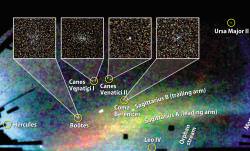 There’s no easy way to put this, our home galaxy is a killer. It’s torn up galaxies in the past, and it’s going to do it again in the future. Each galaxy we consume makes us larger. If you need evidence that this is still going on, you only need to look at the conveyor belt of dwarf galaxies orbiting the Milky Way; each of which will eventually get torn apart, its stars assimilated.
There’s no easy way to put this, our home galaxy is a killer. It’s torn up galaxies in the past, and it’s going to do it again in the future. Each galaxy we consume makes us larger. If you need evidence that this is still going on, you only need to look at the conveyor belt of dwarf galaxies orbiting the Milky Way; each of which will eventually get torn apart, its stars assimilated.
Continue reading “The Milky Way and the Seven Dwarfs”
Planets Born to a Dying Star
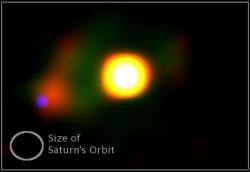 Young stars and new planets go hand-in-hand. But that might not always be the case. An international team of astronomers have discovered a situation where material shed from a dying star is being captured into a planetary disk around a binary companion.
Young stars and new planets go hand-in-hand. But that might not always be the case. An international team of astronomers have discovered a situation where material shed from a dying star is being captured into a planetary disk around a binary companion.
Continue reading “Planets Born to a Dying Star”
Light Echoes from Our Supermassive Black Hole
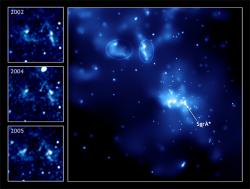 A new set of images from the Chandra X-Ray Observatory show the reflected X-ray emission from a small meal consumed by the supermassive black hole that lurks at the heart of the Milky Way.
A new set of images from the Chandra X-Ray Observatory show the reflected X-ray emission from a small meal consumed by the supermassive black hole that lurks at the heart of the Milky Way.
Continue reading “Light Echoes from Our Supermassive Black Hole”
See the Brightest Comet in 30 Years
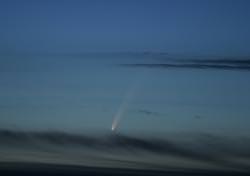 Bad Astronomer Phil Plait is raving about it, our forum is buzzing about it, and there seem to be stories and photographs and popping up everywhere. One of the brightest comets we’ve seen in decades is blazing across the night sky, but you’ve got to move fast if you want to see it.
Bad Astronomer Phil Plait is raving about it, our forum is buzzing about it, and there seem to be stories and photographs and popping up everywhere. One of the brightest comets we’ve seen in decades is blazing across the night sky, but you’ve got to move fast if you want to see it.
Continue reading “See the Brightest Comet in 30 Years”
Eagle Nebula’s Pillars Were Wiped Out Thousands of Years Ago
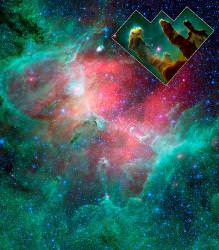 One of the most famous space photographs ever taken is the “Pillars of Creation” by Hubble, an amazing image of the Eagle nebula. But a new image from the Spitzer Space Telescope provides evidence that those towers of gas and dust might have already been wiped away.
One of the most famous space photographs ever taken is the “Pillars of Creation” by Hubble, an amazing image of the Eagle nebula. But a new image from the Spitzer Space Telescope provides evidence that those towers of gas and dust might have already been wiped away.
Continue reading “Eagle Nebula’s Pillars Were Wiped Out Thousands of Years Ago”
Open Star Clusters Die Young
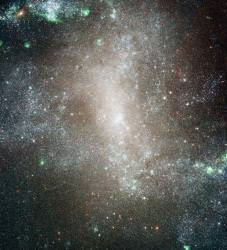 Massive globular clusters are some of the oldest objects in the Universe, held together by the collective gravity of their stars. Open star clusters, on the other hand, don’t live so long.
Massive globular clusters are some of the oldest objects in the Universe, held together by the collective gravity of their stars. Open star clusters, on the other hand, don’t live so long.
Continue reading “Open Star Clusters Die Young”
A New View of Kepler’s Supernova Remnant
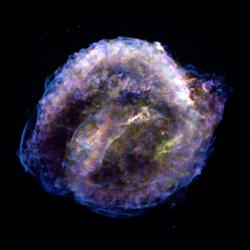 NASA’s Chandra X-Ray Observatory has created this amazing image of one of the youngest supernova remnants in the galaxy. The supernova that created it blazed in the sky more than 400 years ago, before the telescope had even been invented. No problem, though, it was bright enough that you didn’t need a telescope – it reached the brightness of Jupiter at its peak. And one of the greatest astronomers in history, Johannes Kepler was there to see it.
NASA’s Chandra X-Ray Observatory has created this amazing image of one of the youngest supernova remnants in the galaxy. The supernova that created it blazed in the sky more than 400 years ago, before the telescope had even been invented. No problem, though, it was bright enough that you didn’t need a telescope – it reached the brightness of Jupiter at its peak. And one of the greatest astronomers in history, Johannes Kepler was there to see it.
Continue reading “A New View of Kepler’s Supernova Remnant”
Blizzard of Snowflake Particles Around a Young Star
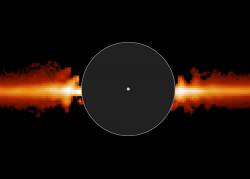 The Hubble Space Telescope has imaged a ring of dust around a nearby star that will probably become a system of planets. The star is AU Microscopii, and it’s located about 32 light-years away in the southern constellation of Microscopium (the Microscope). The particles are probably as fluffy as snowflakes, and about 10 times larger than typical interstellar dust grains.
The Hubble Space Telescope has imaged a ring of dust around a nearby star that will probably become a system of planets. The star is AU Microscopii, and it’s located about 32 light-years away in the southern constellation of Microscopium (the Microscope). The particles are probably as fluffy as snowflakes, and about 10 times larger than typical interstellar dust grains.
Continue reading “Blizzard of Snowflake Particles Around a Young Star”
On Some Planets, the Winds Go Supersonic
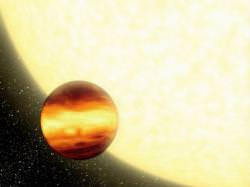 Think of the strongest wind you’ve ever experienced. No, think of the strongest wind anyone’s ever experienced. It still doesn’t hold a candle to the terrifyingly strong winds on some extrasolar planets. There are gas giants out there, with masses similar to Jupiter, that experience winds as strong as 14,400 kph (9,000 mph).
Think of the strongest wind you’ve ever experienced. No, think of the strongest wind anyone’s ever experienced. It still doesn’t hold a candle to the terrifyingly strong winds on some extrasolar planets. There are gas giants out there, with masses similar to Jupiter, that experience winds as strong as 14,400 kph (9,000 mph).
Continue reading “On Some Planets, the Winds Go Supersonic”
Hubble Helps Make a 3-D Map of Dark Matter
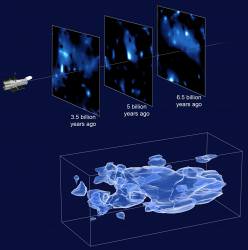 A team of astronomers has created a three-dimensional map of dark matter distribution across the Universe. This map gives some of the best evidence that normal matter, like you and me, stars and planets, accumulate around the densest regions of dark matter.
A team of astronomers has created a three-dimensional map of dark matter distribution across the Universe. This map gives some of the best evidence that normal matter, like you and me, stars and planets, accumulate around the densest regions of dark matter.
Continue reading “Hubble Helps Make a 3-D Map of Dark Matter”
